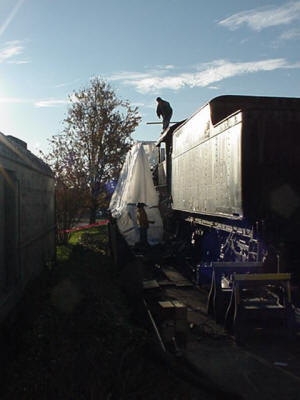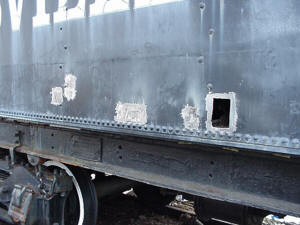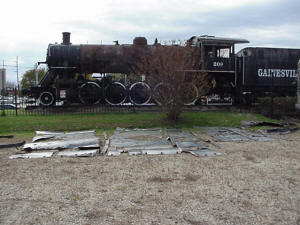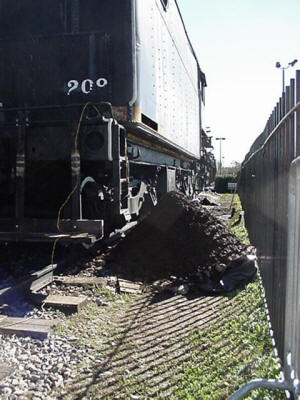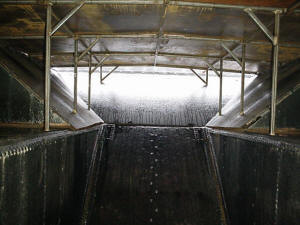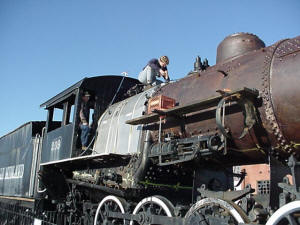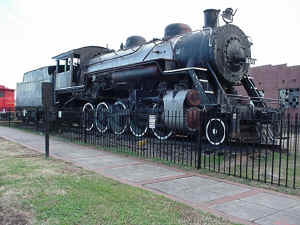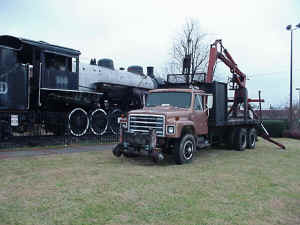|
|
Gainesville Midland No. 209 |
|
story and photos by Dave Lathrop |
A first person narrative of how a small city in the North Georgia hills
took responsible care of its railroad collection without emptying the
treasury in the process.
Gainesville, Georgia is a pleasant community, suffering from having three
roads with bridges crossing Lake Lanier pass through its center, and being
on the edge of Atlanta’s insatiable suburban sprawl. It has long been a
center of poultry production, and now supports a large immigrant
population of chicken pluckers and processors. In the late 1950s, it was
the last bastion of steam in the Seaboard Air Line group of affiliates,
thanks to the Gainesville Midland railroad, which ran decapods and a pair
of 2-8-0’s through 1959, before finally dieselizing in 1960.
Many of the Gainesville Midland locomotives have been more or less
preserved in museums, or as park hulks in communities from Gainesville
itself to Charlotte, NC. Charlotte got a 2-8-0 by accident – it was too
late to preserve a NC steam locomotive by the time they asked the SAL for
one in 1959, but the Seaboard had just retired one in Georgia. With SAL
never one to waste a resource, it pulled a freight into Charlotte, had the
fire dropped, and went to rot in Freedom Park, where it was first
vandalized by the usual suspects, then by the city parks department
itself, who paid to have it stripped of every protrusion to be converted
into a jungle gym in the 1990s. But I digress…….
The engine in Gainesville, 2-10-0 No. 209, escaped a similar fate. It was vandalized in the usual ways, and then largely ignored by most of the citizens for many years. In 1991, it was moved from its original display location along with a steel Seaboard Air Line caboose and a Southern baggage car, and put on display at a traffic-jammed intersection, on land which had been part of the GM yard. A group of local citizens built a small railroad museum in the baggage car, did a paint job on everything, and manned it on weekends for a while. But after these benefactors burned out, nothing much happened for more years. The neighborhood would eventually undergo redevelopment, but before that happened the caboose became overflow accommodation for a local brothel, and at least one person set up housekeeping in the tender tank.
|
|
| A "before" view of the front right side. We didn't
take any full length shots at this point - these are documentation
for how the |
Redevelopment happened, and some of it was actually good. The Gainesville Midland passenger terminal building was saved, but the railroad infrastructure surrounding it removed. Many of the older structures nearby are now being demolished for construction of mostly banks, and a considerable number of other older buildings have been demolished at the nearby square for ugly modern concrete municipal structures and parking decks. The city is now about to redevelop an industrial corridor along the part of the GM which came into the city center, and is making the mistake of removing the track, which could be a valuable future commuter rail link to Atlanta, and serve as a development catalyst if left as an integral part of the plan.
So here we have the sense of the place and time – a community, which was
an agricultural center, under severe development pressure and undergoing
rapid growth, and without the sophistication to control it rather than react
to it. When the real estate people and activists began to complain about the
eyesore railroad collection, and the asbestos leaking through the rotted
jacket, the city was under some pressure to do something about it.
Enter a proposal from a railroad museum in Tennessee, which inspected the
locomotive, and made a formal proposal at a city council meeting to acquire
it. There was an immediate backlash, and the northern brethren were
fortunate to escape without injury. Having been awakened, the city
determined that “something had to be done” and directed Jim Hamblen,
Superintendent of Public Lands and Buildings, to deal with it – and as cost
effectively as possible. Jim is a buildings guru, and has never had to deal
with railroad rolling stock before, but he is the perfect kind of public
sector manager to deal with an unfamiliar contracting problem. He has been a
construction contractor, been around a lot of different kinds of projects,
and knows what good management is. He isn’t easily phased or upset, and is
practical and comfortable with a learning curve.
I met Jim at the site in August where we looked over the situation
generally.
The locomotive, tender and caboose sit on a landlocked section of track
facing the corner of the block. The entire side of the block is occupied by
the city owned property holding the railroad collection. A concrete walkway
separates the tender and the caboose, and leads into the side door of the
baggage car, which occupies another shorter section of track. All pieces are
enclosed by an iron fence, which also separates the city owned property from
the privately owned empty lot behind. Power is from a pole to the rear of
the caboose, and the baggage car lights and a few outlets are hard-wired in
underground. The empty lot is accessible only from the street to the rear of
the caboose, and is a good place to bring in a crane, load parts, tools and
supplies in and out, and park work trucks. A water standpipe for a hose
connection is near the power pole.
Logistically, the project didn’t seem too difficult despite the outdoor
venue. We could install a 220 outlet on the pole for the welder, and run a
looooooong drop cord. The baggage car could be secured and used for tool
storage. Things were looking more possible.
The hazardous remediation of the asbestos was a priority, and an asbestos
contractor proposed he bring in a crew, remove all the piping and other
impediments with a torch and scrap it out, and then remove the asbestos and
jacket. A local painter could then paint the boiler shell, as well as the
tender, baggage car and caboose.
While relatively inexpensive, this proposal was not universally admired
within the city government. Several people remembered the locomotive as it
had been, and one fire chief in particular opined that it would be better
scrapped than treated that badly.
Jim determined that, if it could be afforded, the locomotive should be stripped with a wrench, then the asbestos remediated, then rejacketed and reassembled before repainting. A budget of $75,000.00 was set aside for cosmetic restoration of all three pieces. Jim now had to figure out how to do all that with those limited funds, and, by the way, preferably within 120 days. It was now September, and fall and winter in the hills can present unpredictable periods of nasty weather. All work had to be done outside where things sat.
I was just finishing up an intensive replication of a Marietta streetcar from the hulk of a Cincinnati Curveside streetcar body, and looking forward to a short vacation in Pennsylvania and New England. I couldn't make myself available to start the job until late October. I didn’t know just what could be done with the $39,900 set aside for the locomotive work, but was pretty sure we could at least do the disassembly, install a new jacket made by the local sheet metal shop, the reassembly, replace the wood deck on the tender, and patch the rot holes in the side of the tender tank. Beyond that, some conservation work and detail repairs could possibly be done. I could work on making bits and pieces look good until he got tired of writing checks. Jim offered the use of the city maintenance shop and whatever resources he could provide without interrupting his ongoing work too much, and had some flexibility in the deadline. He could provide local references for suppliers. He had separately contracted with an asbestos remediation contractor and painter, both of whom were beyond my control, yet the deadlines I had to meet were dependent on their getting their work done in a timely way. We agreed in principle on a “not to exceed” contract, and I went on vacation with the idea of starting work upon my return.
Knowing I would need some strong young and qualified assistance, I called
Jason Sobczynski in Michigan, who had just finished working a temporary
series of projects for the Henry Ford Museum in Dearborn. Jason is from the
Atlanta area, and knows where every scrap yard and source in North Georgia
is located. I had previously hired him for the shop in Savannah when I was
moving on, and they needed a good steam mechanic and skilled shop guy who
was younger than the locomotives. Jason was pleased to head home and take
part in the project, 209 had been of particular interest to him for a while.
In late October, I returned to Gainesville to sign the contract, get keys,
and arrange to begin bringing in tools to get to work. One requirement was
general liability coverage, with the city as additional insured. I called
the railroad specialty insurance agent I had used in a similar situation
before, whose representative assured me I could expect coverage within a
couple days at favorable rates. I went to load the truck and get started.
October 27, 2004: I arrived with a truckload of tools to find the street,
which offered access to the empty lot, torn up and blocked. Turns out the
city street department doesn’t take the plans of the city buildings and land
department into consideration when starting repaving jobs. We were advised
it would be a quick job lasting no more than a couple weeks. Jumping the
curb, I unloaded on the grass, and hauled everything the long way into the
baggage car. The baggage car, of course, needed to have the lighting
repaired, the doors made operable, and be generally cleaned out. Jason
arrived at 2pm and we got very busy. We soaked everything on 209 down that we thought we needed to
remove with PB
Blaster.
Jason had another surprise, but a pleasant one. He called two old
acquaintances of his who are affiliated with the Hartwell Railroad, and are
available on weekdays. Enoch Craven and Warren Douglas volunteered for the
duration of the project. Enoch in particular was devoted to the project,
since he grew up in Gainesville, and, when he was a child, visited his
father in his office within view of the GM enginehouse. Disassembly ensued,
and by October 28, general repairs were complete to the baggage car, the cab
was stripped, and an outhouse had arrived. We began removing piping,
appliances, and whatever else looked like it was in the way of abatement.
I still had not received an insurance policy. Repeated inquiries did not result in a resolution. On November 1, I stopped in at a local insurance agency, and bought a policy that satisfied the city’s requirements in 20 minutes. Work continued to progress in loosening and removal of miscellaneous hardware, for the next few days, including documenting what went where. Arnie Johnson, from the Southeastern Railway Museum, stopped in to help one day and handled the grubby job of unplumbing the lubricator and associated lines. Many things unbolted with little trouble, but just as many needed some thermal persuasion before loosening. A few bolts couldn’t be loosened, and were burned off.
By November 8, we were ready for a crane to lift off the heavy parts,
having removed all the small stuff manually, and called to schedule one for
November 9. Meanwhile, we started to prepare the tender for jacking the tank
off the frame to replace the wooden deck. On November 9th, no crane arrived,
and we were in the middle of installing new treated 2X10 wood decking when
some rigging and trucking types showed up, and proceeded to start measuring
all the rolling stock. I hastened to assure them that all I needed them to
do was lift off the heavy items – air pumps, reservoirs, running boards,
domes. They asked me how much the locomotive weighed. I was puzzled……..
Until I discovered that they weren’t my riggers. They were a crew out of
Atlanta, hired by Gladys, the owner of the adjacent property, to bid on
moving the locomotive and baggage car to another location in town, and take
the caboose to an antique mall in the NC mountains. None of this was known
by the city. Gladys no doubt wanted the rest of the block for development,
no matter that she didn’t own it. A case could potentially be made that a
location on track might be a better venue for the display, and the benefits
of returning the city property to the tax roles might be worthwhile, but it
did come as a bit of a surprise. We debated the relative ease of moving the
stuff on its own wheels rather than by heavy haul lowboy (you need to see
the location to understand) with the riggers, and then gave Gladys an
estimate when she showed up later on. I’m not holding my breath.
So far, the weather had been unseasonably fine, and we were anxious to get
the heavy lifting done before the arrival of rains predicted for later in the week. We tried to reschedule the boom truck for November 10th, but no
luck there either, although we did make good use of the day for more tender
work. The whole crew spent the cold windy morning of November 11th rigging
in the driving rain, and we managed to get all the heavy lifting finished,
and the boom truck back to the barn, within the three-hour minimum charge.
Soaked and shivering, I bought everybody lunch at IHOP across the Poultry
Park from the engine.
The asbestos contractors started work the following Monday, and were done and gone by Thursday. We took advantage of their occupying the locomotive to start cutting out rotted areas of the tender tank.
During the following week, we brought in the local sheet metal shop to look at the sections of old jacket we had patched and laid out in the empty lot. Wallace Sheet Metal offered to donate half the cost of the job, and to assist us with the use of their shop for other small specialty jobs. Rather than use 14-gauge sheet iron, we specified 20-gauge paintable galvanized steel. They planned to have the jacket finished within two weeks.
The two week paving project showed no sign of coming close to reaching its
conclusion, even though we were now in the fourth week of the job, and the
paving guys were making much more use of the outhouse provided for our job
then we were. The week of November 22 was rainy and nasty, so we took a few
days off.
It was OK because the
volunteer and other community support was moving the work on more rapidly and at
lower expense than originally envisioned, so we could do some extra work,
and to
conserve and document what was there. Although it wasn’t in the contract, we did clean out the firebox and blow
the flues, and empty the ashpan. Not only will this help preserve the
remaining metal, but we found the broken-off outer half of the throttle
lever and much of the wooden cab doors in the firebox. We also cleaned out
the smokebox, and squirted Great Stuff into areas we wanted to prevent water
from entering again.
We took the time to do some ultrasound measurements in the usual trouble
spots on the boiler, since the locomotive itself didn’t show any “red flag”
conditions which might preclude its operating restoration at some future
date, if desired. The boiler tests did not reveal any bad areas, apart from
some sections of the firebox as is commonly found. A sketch showing the
tested areas and results was done for the city to keep in their files.
While the locomotive is in decent shape, the tender is total junk. The
center sills are badly cracked by the front bolster, and the cast frame
badly eroded in many places. Both trucks are in terrible condition, with the
bolts holding the truck frames together either worn or bent into crankshaft
configurations. I have alluded to tank rot – it is apparent that isn’t a
recent thing. The railroad had done some extensive patching, both flush and
scabbed. The tank baffles were gone at the lower ends. The floor was ankle
deep in rust scales and trash.
The rotted-through areas provided some access for shoveling out the
accumulated stuff. It wasn’t a lot of fun – hunched over with a broom and
shovel, hauling 50 pound buckets of grunge around baffle remnants to where
you could shovel it out through the side sheets. While I was working in the
tank alone on Saturday, an undocumented alien stole the license plate off my pickup,
which led to an interesting conversation with the police later that night.
Still, it will help preserve what remains of the tank.
We repaired the removed sections using the same technique the railroad had
used in adjacent areas, either flush or scabbed. We treated the inside of
the tank (where it seemed reasonable) with Ospho rust converter. After
making all inner repairs, we installed a padlock on the tank hatch to
prevent further trashing.
The coalbunker presented another challenge. These locomotives had been
retrofitted with Berkeley stokers, and the troughs were natural grunge and
rust pits. The slope and side sheets of the tank were badly worn and
patched. The solution was to build a low, sloped roof over the bunker, which
isn’t visible from the ground. To save money, we used recycled steel from a
local scrapyard. This, combined with welding closed the coal doors and
making a top for the front of the tender, created a secure storage space
where we could entomb such items as little copper lines and fittings, and
the in-cab jacket, which we were not reinstalling.
The rear buffer beam was rotted in part, but the bolts were good, and it
wasn’t drooping much, so it was filled with vinyl concrete patching
compound. I got the idea from a dental appointment a few days previously.
Going into week 6, the 2-week paving job was still going strong, with the
contractors doing such things as digging holes in the morning and filling
them in again in the evening, only to dig them up again the next day. The
painting contractors began work on the baggage car December 8th. The new
jacket was to be laid over a spacer of Styrofoam, to replace the asbestos. A
personal visit and short storytelling session with a local foam company got
the foam donated entirely.
The weather was nicer, cool but sunny. We treated the entire boiler shell with Ospho, and went to pick up the jacket on December 13. The jacket was not done; there were some questions to be answered. Answers and motivational commentary ensued. We took advantage of the delay to do some little customization jobs, like fabricate and install some little circular steps to the front of both sides of the tender tank. They had been removed at some point, but the evidence of their location was visible, and the sister engine in Winder still had them to copy. Winder also loaned us their firedoor handle to replicate as well. Over the next couple days, we took the piping to the city shop for the painters to clean and prime, and repaired the appliances, domes, running boards, etc., there so the painters could get a head start. On the 16th we picked up the bulk of the new jacket, and started gluing foam strips on the boiler with construction adhesive.
December 20 through 22 was spent installing all the big parts of the jacket
over the foam. After being manhandled into place, we used nylon strap clamps
($1.99 on sale at Harbor Freight) to cinch them semi-tight. The top seam was
pop riveted together, and then the old jacket clamps, which had been
cleaned, bolted to the bottom. Using threaded rod and nuts, we tightly
cinched the new jacket sections over the foam. Once tight, the bottom seams
were also pop riveted together. We broke for the holidays.
The last week of December was spent doing finishing details to the jacket,
such as washout plughole flanges, and seam band installation. We also
installed the cylinder jackets, and repaired or ran new electrical conduit
for cab, head, and backup lights. Working lighting was another little extra
we decided to provide. The only problem with the jacket, left to solve, was
the circumferential ring, which closes the front off just at the smokebox.
Broke for another holiday.
The street-paving job was almost finished, the crews having largely moved on
during the holidays, with only the occasional worker and truck coming back
to do details. The street department was kind enough to haul over and unload
the heaviest parts from the city shop – the sand dome and air compressor.
This saved the cost of rigging at the city shop end.
Rigging at the site was donated by B.R. Anderson and the Hartwell
Railroad, who graciously allowed their boom truck to be used for 3 days in
Gainesville. It arrived on January 3, and departed January 6. Having 3 days
to hoist and fit all the big ugly parts and associated piping without paying
for a crane saved thousands, and allowed us to do a better job without
having to hurry.
The second week in January saw most of the smaller parts and cab fittings
fabricated, repaired, or cleaned and installed. The painters had taken
advantage of one good day to pre-paint the backhead black, before all our
stuff got bolted back on in the way. On January 13, we finally got the front
jacket ring to fit properly, having altered it three times, and brought Jim
Hamblen in to inspect the job, and choose what finishing details we would
complete.
We agreed to provide and install some new valve handles where some had been
stolen, and mount and wire the lighting. Some open pipes would be plugged,
and we would make a fake whistle out of PVC and mount it on the dome.
Taking off a couple valve handles to match, I went to the local plumbing
supply. They had never seen anything like valve handles, and had no idea
where I might get some. Wouldn’t I rather just buy new valves and replace
the old ones instead? One call to McMaster Carr and matching handles in 3
obsolete sizes were on the way.
On January 19 and 20, everything but the gauges and whistle was complete.
209 had lights burning bright all night long the evening of the 20th, for
the first time since 1960.
Enoch had taken the smashed and rusty pressure gauge faces home to clean and
repaint. He returned and installed the repaired gauges, which looked like
new. Jason made the whistle, which Enoch volunteered to install, since Jason
had commitments to work in the frozen north. I submitted a final invoice
January 27.
There was enough left in the budget to allow Jim to do some much needed
landscaping and other work on the area, none of which had been included in
the original estimate. Everybody was happy, we were done ahead of deadline
and under budget, and provided more nice finishing details and conservation
work than we agreed to do.
I passed through Gainsville on March 29th. The reports that the
painters had finished painting 209 were true. A local sign company will attend to
the lettering in the near future, and the city shop is still working on the wooden parts.
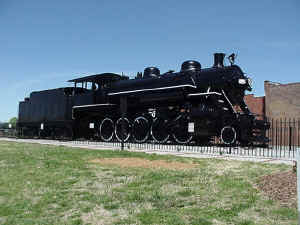 |
|
No. 209 as seen on March 29th. The painting is complete, but the lettering and fabrication of wooden parts is still in progress. |
Postmortem
This project worked well thanks to the unusually high community
support and interest, and good management at the city level. Jim Hamblen ran
interference and provided support, but never once looked over our shoulders
and tried to tell us how to do our work. Our volunteer help essentially
doubled our work force, at no additional cost. The local businesses that
provided in-kind donations of very high quality saved thousands of dollars,
as did the Hartwell Railroad through the use of their boom truck. Were it
not for this support, only a bare bones patch and paint job could have been
afforded after the remediation.
Of course, from the other perspective, without involving experienced professional contractors who know the craft of steam and railroading (even if they do resemble Albus Dumbledore and Alfred E. Neuman), the city could not have gotten a good job done at any price. Jim Hamblen is a man with the perspicacity to know when he needs to get specialized help to supplement his crew. He is also aware that the contractor / client relationship needn’t be adversarial. Would, that all public sector people were like him.
Apart from the pride in the job, the most gratifying things from my
perspective were the visits we got from ordinary citizens who had either
been watching as they drove by, or seen the newspaper or TV articles. Nobody
expressed anything other than support and interest and pleasure that their
tax dollars were going to a worthwhile cause. On several occasions, I took a
few minutes to unlock the caboose so a parent or grandparent could take
their toddler inside. One older gentleman, who worked on the London and
North Eastern before immigrating and working for decades as a truck driver,
had tears in his eyes as he told tales of steam. For the first and only time
in my career, I was asked by a black visitor if the locomotive had a “real
McCoy” lubricator – unfortunately, it had a mechanical instead, but nice to
know somebody remembers that bit of history. The wide-ranging support across
many segments of the community was very much in evidence.
What didn’t work: it’s smarter to be lucky than it’s lucky to be smart, but
you can’t count on the fates to be sympathetic. I wouldn’t have been
satisfied with the job we could have done, had we not had volunteer and
in-kind support, given the available funds. Possibly the city would have,
but not as likely. Our ability to provide more than we said we would
certainly forestalled any potential dissatisfaction, but given
specifications for any restoration job are by nature sketchy, there may have
been some disagreements if we could not. Had a less able manager than Jim
been in charge, the interaction of several different contractors in a small
fenced area could have turned into a Three Stooges scene.
If I had to start fresh with a similar project in another town, I would want
to make sure there was about $80,000 available for the locomotive alone,
exclusive of abatement. I would encourage the city to seek out community
support with the idea of potentially cutting the job cost by a third, and
would aim higher in my initial project conception.
There are other creative ways costs can be cut – mileage and lodging are not
inconsequential, for example – but at my stage of life, while I want to do
what I can to work with clients in any way possible, I am not interested in
setting myself and them up for a job that is sure not to please anybody just
to save a few bucks. I’d rather they either find the locomotive a better
home, or, better, raise funds adequate to assure a good job that will please
all parties. Compared to the huge expenditures for other civic projects,
even at retail cost, locomotive restoration is a relative defensible bargain
(provided it has a constituency). I wouldn’t be surprised if Gainesville
didn’t spend more on the adjacent street paving than on the entire railroad
project – and nobody came by to voice their support for that work, just
aggravation at the traffic disruption.
For any readers working with communities who are considering restoring their
park hulks, but have visions of hundreds of thousands of dollars in costs, I
hope this blunt and meandering narrative might help put those fears aside.
You can of course spend a couple hundred thousand, and get a museum quality
result or an operating engine in return, but it is hard to justify that kind
of expenditure on something you intend to leave unsecured, outdoors, in the
weather and ignore for the next decade or so. But if your community is like
Gainesville in that they do care and want to do a responsible and competent
but practical job, with an appearance that will do the community proud, it
can be done for a lot less, especially with the support of the community.
